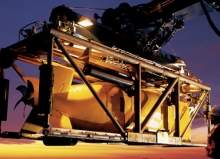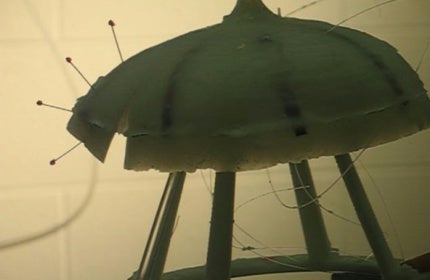
In recent years, shallow-water littoral zones have become an increasingly important consideration for the world’s naval forces. The threat of piracy in regions like the Gulf of Aden along the Somali coast is the most high-profile example of this shift to the shallows, but modern navies are also aware of the potential for terrorist incursion and smuggling in these zones, as well as day-to-day border patrol operations and preparation for more conventional naval threats.
But with so much coastline to cover, especially in a huge country like the US, there’s only so much that manned platforms like littoral combat ships and submarines can accomplish.
With such a wide frontier and so many potential opportunities for incoming threats, an ideal littoral surveillance system would be able to provide the kind of persistent vigilance which conventional vessels simply cannot accomplish.
However, advances in robotics, remote control and automation are making unmanned systems a more feasible prospect for the role of persistent littoral surveillance.
From SOSUS to PLUSNet: the future for undersea surveillance?
Back in 2005, the US Navy’s Office of Naval Research (ONR), along with the Defense Advanced Research Projects Agency (DARPA) began work on developing such a system. The concept behind PLUSNet (persistent littoral undersea surveillance network) is to create a semi-autonomous controlled network of fixed bottom and mobile sensors, potentially mounted on intelligent unmanned underwater vehicles (UUVs) to keep a constant eye on littoral zones.
Related project
M80 Stiletto Next-Generation Littoral Vessel
The M80 Stiletto is a prototype naval ship manufactured by the M Ship Company, to meet specific requirements of the Pentagon’s Office of Force Transformation.
Vehicles believed to be part of the network include several underwater gliders, the Bluefin-21 autonomous underwater vehicle (AUV) and the latest iteration of Pennsylvania State University’s (Penn State’s) Seahorse UUV.
This type of system has a precursor in the US Navy’s sound surveillance system (SOSUS), a series of fixed underwater hydrophonic arrays installed in the Atlantic and Pacific oceans in the mid-1950s to track submarine movements during the Cold War.
SOSUS has now mostly been given over to scientific use, allowing researchers to gather data on underwater seismic activity and marine mammal vocalisations, among others.
Meanwhile, trends in naval research are leading to a technological shift in underwater surveillance, moving from fixed sensor arrays to mobile platforms mounted on UUVs. "We’ll need to leverage technology and create a network of interconnected sensors with submarines as the hub of that network," said Vice Admiral Jay Donnelly, US Navy submarine force senior commander, at a Submarine League symposium in October 2010.
"We’ll use unmanned undersea vehicles and distributed netted sensors to serve to expand the sphere of influence that our submarines have, and will enable persistent presence in more areas of the world," Donnelly added.
"Eventually, unmanned undersea vehicles and distributed netted sensors will likely replace our permanent fixed undersea sensor infrastructure, which in many cases is beyond its design life."
PLUSNet, various elements of which have been contracted out to a number of US universities and naval research centres, could be the framework under which this networked web of underwater spy systems is eventually developed. Since the project was kicked off in 2005 with a $27.7m contract awarded to Penn State, there has been little information released about the initiative’s progress, although news emerged that the navy hoped the system could be operational by 2015.
While persistent littoral surveillance remains a future concept, technologies being developed today, both as part of PLUSNet and outside of it, give us some indication of how an integrated underwater surveillance network could operate.
Underwater gliders: naturally stealthy
Underwater gliders, with their ability to achieve propulsion and cover large areas of littoral waters using very little power, are naturally suited to stealthy marine surveillance roles.
Several glider platforms are being developed as part of the PLUSNet project, including the X-Ray advanced underwater glider, a prototype of the US Navy’s Liberdade series, a group of gliders aiming to achieve a range of 1,200-1,500km and on-station capabilities of up to six months in loitering glides at partial buoyancy.
Reputed to be the world’s largest underwater glider, X-Ray’s size is to its advantage in a surveillance role, as it can maximise its hydrodynamic efficiency, onboard energy storage and sensor payload.
The glider is equipped with everything it needs to autonomously patrol large areas and track quiet diesel-electric submarines which can operate in littoral waters, including acoustics and electric field sensors, as well as satellite communications.
Another advanced underwater glider that could form part of PLUSNet in a very different capacity is Seaglider. Primarily developed by the University of Washington’s Applied Physics Laboratory (APL) as an oceanographic data collection device, Seaglider is also a potent communications tool.
When tied into the wider PLUSNet network, these gliders could act as local communications anchors, as their radio frequency / GPS telemetry allows them to automatically surface and transmit data received from elsewhere.
Autonomous underwater vehicles: onset of AUVs
Development of AUVs and UUVs has increased in recent years, with new projects building an increasing level of inbuilt intelligence and control sophistication to these vehicles, many of which are being used to house sonar and other underwater sensing technologies.
Typical AUVs likely to be included in PLUSNet include Bluefin Robotics’ Bluefin-21 Battlespace Preparation AUV (BPAUV), an autonomous vehicle already designed for the US Navy to carry out mine countermeasure missions in shallow water.
BPAUV’s advanced 455 kHz side scan sonar provides high resolution bathymetry and bottom classification data at ranges of up to 75 metres. The platform’s modular design (allowing sub-systems to be swapped out based on mission requirements) and ability to navigate without acoustic sensors make it a well-suited workhorse for littoral surveillance and anti-submarine warfare (ASW) roles.
Recent AUV developments have been pushing for even more intelligence in automated subsea systems, and in an underwater battle space there is more scope to build larger platforms to house a wider range of tech. Boeing’s Echo Ranger LDUUV (large displacement unmanned underwater vehicle) has not specifically been indicated for use as part of PLUSNet, but its development for the ONR and its impressive capabilities certainly mark it as a likely candidate.
The size of the five-ton Echo Ranger affords it space to incorporate more sophisticated automation, allowing it to traverse cluttered littoral waters autonomously using sonar. The system’s acoustic sensors also allow it to detect and identify approaching vessels from several miles away, giving it time to manoeuvre appropriately.
"In terms of autonomous operation, we’re pretty much there," said Mark Kosko, Boeing’s programme manager of unmanned undersea systems, at Defense Technology International at the beginning of April 2012. Future refinements of the technology include potentially installing diesel engines or fuel cells to prolong Echo Ranger’s current operating limit of 28 hours.
Networked sensor technology
Intelligent underwater vehicles are clearly the best method of hosting various sensor technologies and delivering them to the right place at the right time, but what about the sensors themselves? Underwater sensor development projects being conducted in the US and elsewhere are improving the imaging and communications functions of sensor systems, providing a speculative glimpse of what could be in store for a networked underwater surveillance system.
In 2010, researchers at the US Naval Postgraduate School in Monterey, California, unveiled Seaweb, a system strikingly similar in concept to PLUSNet, after more than ten years of development. Seaweb is an acoustic communications network which uses through-water acoustic modems to connect up a large number of sensor nodes to a surface gateway node, allowing real-time digital communication between data gathering sensors and land-based command centres.
"Our original goal was to create a network of distributed sensors for detecting quiet submerged submarines in littoral waters where traditional ASW surveillance is challenged by complex sound propagation and high noise," said the programme’s principal investigator Professor Joseph Rice.
"But as Seaweb technology developed, its broader overarching value became evident."
Beyond its original design parameters, Seaweb has also been shown to be a remarkable command and control system for compatible UUVs. Its ability to interface with mobile platforms could be the key to greater organisation of operations undertaken by unmanned vehicles or even fully crewed submarines. "In short, Seaweb integrates undersea warfare systems across missions, platforms, systems and nations," Rice said.
Biomimetics: inspired by nature

The humble jellyfish inspired a group of ONR-funded researchers at UT Dallas to create a platform which they dubbed ‘Robojelly’.
Although it’s clear that researchers like Rice and his team are perfectly capable of designing incredibly sophisticated automated surveillances devices under their own steam, an growing trend in underwater tech design (among other fields) is biomimetics, or taking inspiration from the most impeccable designer of all: nature.
Using biological evolution as a template, it’s possible to synthesise certain aspects of natural design to come up with concepts which would be almost impossible to conceive otherwise.
In the field of underwater stealth surveillance, the humble jellyfish’s perfect harmony with its environment has inspired a group of ONR-funded researchers at the University of Texas at Dallas (UT Dallas) to create a platform which they have playfully dubbed ‘Robojelly’, a robotic platform that mimics the moon jellyfish’s effortless movement to power itself with only hydrogen and oxygen – two gases that the ocean provides in abundance.
"We’ve created an underwater robot that doesn’t need batteries or electricity," said the study’s lead author Dr. Yonas Tadesse last month. "The only waste released as it travels is more water…It could stay underwater and refuel itself while it is performing surveillance."
This remarkable feat of self-sustaining energy is accomplished using synthetic ‘muscles’ wrapped in platinum-coated nanotubes that create heat and water vapours when exposed to hydrogen and oxygen. This heat causes the muscles to contract, pumping water and generating forward momentum. The next step for the technology, which has obvious applications for the long operating periods required by persistent surveillance, is to allow the legs of the device to move independently, unlocking the ability to travel in more than one direction.
It’s clear that enough innovative underwater technology exists to make each component of a PLUSNet-type system achievable today or in the near future. The challenge for the US Navy, and any other modern fleet considering a similar project, will be to bring all of these technologies together under one roof to create a unified system capable of maintaining a constant vigil below the waves.
Related content
NSSN Virginia Class Attack Submarine
The Virginia Class attack submarine is an advanced stealth multimission nuclear-powered submarine for deep ocean anti-submarine warfare and littoral (shallow water) operations.
Cape Class Patrol Boats
Cape Class Patrol Boats (CCPBs) are being built by Australian ship builder Austal for the country’s Customs and Border Protection Service.




